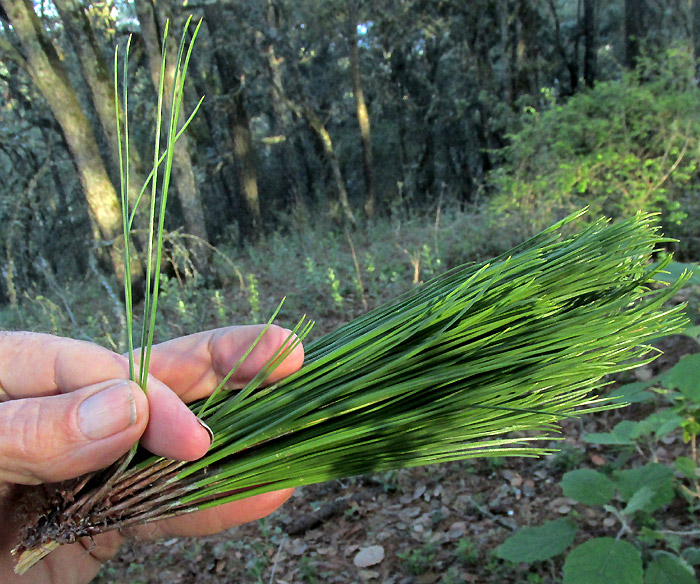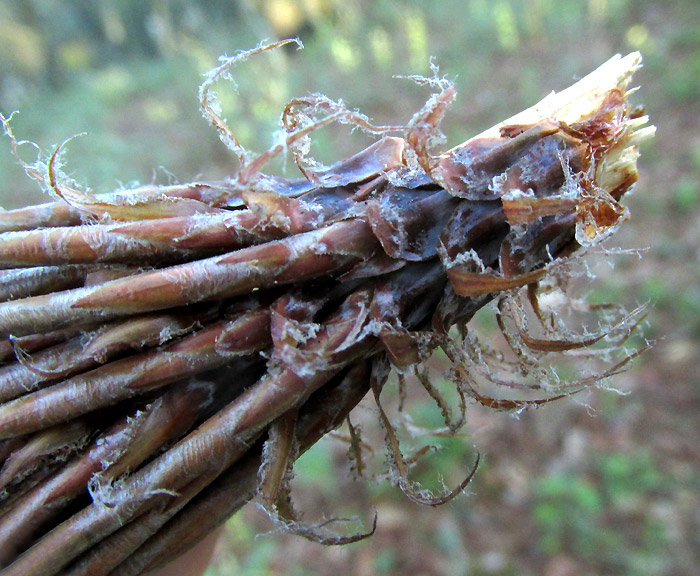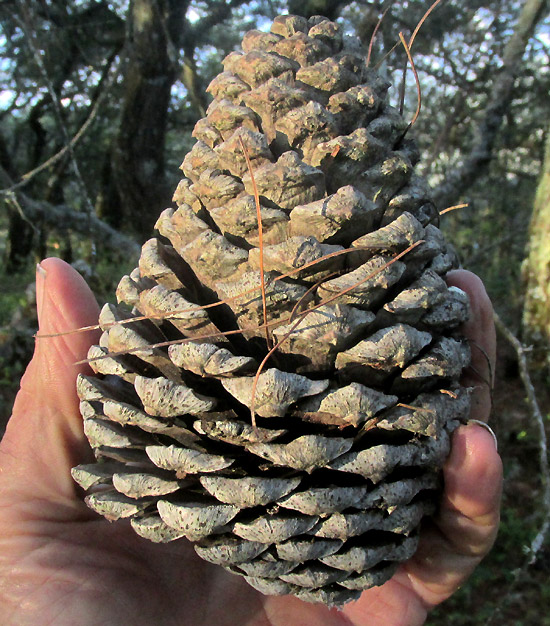Entry from field notes dated September 2, 2023, taken in Los Mármoles National Park in the Eastern Sierra Madre mountains, Hidalgo state, MÉXICO; oak-pine forests along ridge beside road leading to Puerto de Piedra, which branches off the road between Trancas {on maps designated "Morelos (Trancas)"} and Nicolás Flores; limestone bedrock; elevation ~2,550m (~8,400ft); ~N20.81°, ~W99.23°
MEXICAN MOUNTAIN PINE

It's good to sleep in a tent beneath a tree such as the above, and upon awakening pull the flap back, look up and see the morning's first warming beams of sunlight barely touching the tree's uppermost branches. That morning, already several Black-throated Green Warblers, Setophaga virens, were flitting among those top branches.

To know what kind of pine the tree was, I couldn't reach lower limbs, but the ground was littered with several snapped-off branch tips, probably courtesy of gnawing squirrels. Important for identification was what's shown separated from the big tuft of needles, held between my fingers: Six needles arose from the needle-cluster base, though later I saw that most clusters contained only five. The needles were about 12cm long (4¾in).

Clusters of needles arise from cylindrical sheathes composed of overlapping scales, as seen at cluster bases on the above picture's left side. In pine identification, it's important to note whether the needle cluster scales at the base fall off soon after the needles develop, or persist. Also, the lower scales can be long or short. This pine's lower scales appeared to be solidly attached for long duration, plus they were unusually long and slender, and their margins were white-hairy -- all good field marks. The above persistently scaly twig can be those of Pinus pseudostrobus with early-deciduous scales, a species also found in this area.

Cones dropped beneath the tree were large, with their woody scales separated from one another for expelling their seeds.

The tree's trunk bent somewhat at the base, maybe because as a sapling it had to grow toward light. But now it had become an elder in the forest, it's bark deeply fissured and ornamented with lichen and moss.
The 2021 work by José Luis Villaseñor and others entitled "Riqueza y distribución de la flora vascular del estado de Hidalgo, México" reports that here in upland central Mexico's Hidalgo state 15 pine species, genus Pinus, are documented. Among our pine's most distinguishing features are its needles in clusters of five or six, the needle's length varying around 12cm, the long, narrow scales persisting on the woody twigs, and the hefty size and oval shape of the cones. All those field marks point to PINUS HARTWEGII, variously called Hartweg's Pine or Mexican Mountain Pine. For such a noble, solidly Mexican pine having little to do with German botanist Karl Theodor Hartweg, other than some of its twigs and cones having been collected by him in the 1830s in the Angangueo mountains of Michoacán state, I prefer Mexican Mountain Pine.
Pinus hartwegii is a species finely adapted to high elevations -- up to 4,300m (14,100ft). Here in central Mexico, if you climb a mountain up to where the treeline ends, the last big trees left standing before alpine meadow begins will be this species. As such, its distribution isn't continuous through mountain ranges, but rather it gathers in isolated populations on higher peaks. Wikipedia provides a distribution map locating its island populations from northern Mexico south in high mountains to Honduras.
The 2019 study by Rebeca Dennise Varo-Rodríquez and others entitled "Uso tradicional de la fitodiversidad de los bosques de Pinus hartwegii en dos comunidades mexicanas de alta montaña" examined plant use by traditional communities in highland central Mexico located amid forests in which Pinus hartwegii was the dominant tree. They found that the villagers used 51 forest plant species. Using statistical analysis they demonstrated that the most useful species of all was Pinus hartwegii itself, which the villagers called ocote, a general term for all pines.
It was used for purposes of medicinal therapies (a resiny tea for coughs and colds, brewed with needles in boiling water), construction, as firewood, and in and around the house its boughs were used for animal bedding and for green ornamentation during rituals and holidays, particularly Christmas. Interestingly, the second-most useful plant was another high-elevation specialist, the medicinal herb hierba del sapo, employed for kidney pain and prostate problems.
Adapted from Jim Conrad's Naturalist Newsletter of October 8, 2007, with notes made during a visit to Nevado de Toluca Volcano; elevation ~4,000m (~13,100ft); N19.126°, W99.777°; México State, MÉXICO
TIMBERLINE MONTEZUMA PINES
As soon as the ice melts from my tent fly I head downslope. Once below the timberline I locate a spring and erect my tent on a parklike ridge with widely scattered pines and more clumpgrass. You can see the view from my tent door below:

The pines are Pinus hartwegii, sometimes known as Timberline Montezuma Pines.
With that fine view, sitting in my tent as it glows in the afternoon sunlight, a mellow warmth overcomes me, almost the opposite to the feeling of all that sun and wind above the tree line. What a pleasing thing is a long afternoon nap in that glowing, peaceful spot.